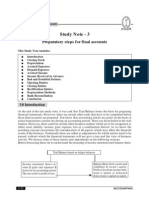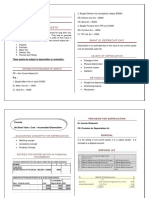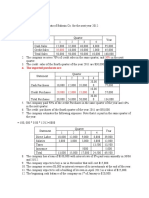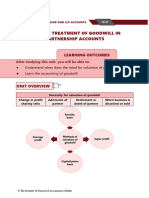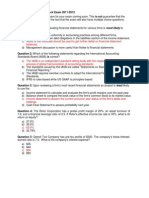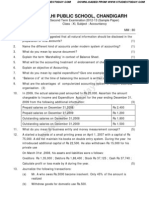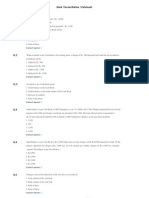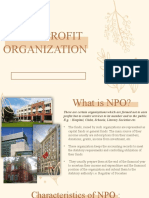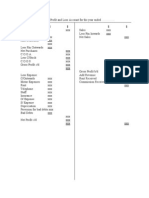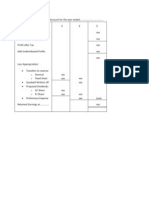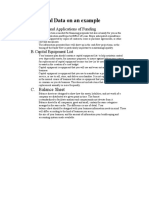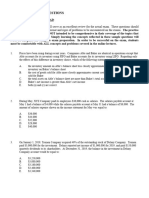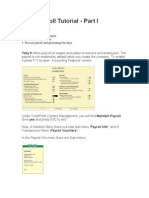Non Trading Organization
Non Trading Organization
Uploaded by
PBGYBCopyright:
Available Formats
Non Trading Organization
Non Trading Organization
Uploaded by
PBGYBCopyright
Available Formats
Share this document
Did you find this document useful?
Is this content inappropriate?
Copyright:
Available Formats
Non Trading Organization
Non Trading Organization
Uploaded by
PBGYBCopyright:
Available Formats
Non-Trading Organizations
A business concern is an organization involved in activities of buying or selling goods and services with a view of making a profit. There are associations, clubs or societies which are not formed for the purpose of making profit. These are called non-trading organizations. They are formed to cater and promote the sporting, cultural and recreational interest of its members. Although these organizations do not sell goods or services they do earn income and incur expenses. Their income is derived mainly from its members subscription fees, donations or sponsorships. These incomes are used to finance the daily activities or programs carried out by the organization. Since the income comes mainly from members, proper accounts need to be kept and financial statements need to be prepared and presented to its members at the end of each financial year.
Receipts and Payment A/C
This account is a summary of all receipt and payment items that appear in the cashbook. In fact, it is a cashbook given a different name. Its main features are: a. The balance at the beginning and at the end of the accounting period represents the amount of the cash in hand and cash at bank at the start and end of the period. b. All receipts, regardless of revenue or capital receipts are recorded on the debit side. c. All payments regardless of revenue or capital expenditure are recorded on the credit side. Receipts and Payment A/C
Final Accounts
The final account for a non-trading organization is the income and expenditure account. The income and expenditure account of a non-trading organization is equivalent to the profit and loss account of a business organization. The purpose of the income and expenditure account is to determine whether there is a surplus or deficit of the income over expenditure. The principles involved in the preparation of such account are very similar however its distinguished feature as follows: 1. Only revenue expenditures are recorded on the debit side 2. Only revenue incomes are recorded on the credit side 3. Only items relating to revenue expenditure and revenue income which ought to have incurred and earn for the particular current period are recorded here. 4. Revenue expenditure and revenue receipts relating previous periods and subsiding periods cannot be recorded here 5. All capital items i.e. capital expenditure and capital receipts cannot be recorded here
6. If the total revenue receipt i.e. the credit total exceeds the total of the revenue expenditure i.e. the debit total, it indicates a surplus of income over expenditure (net profit) excess of income over expenditure 7. Where the total debit i.e. revenue expenditure exceeds the total credit balance i.e. revenue receipt it indicates a deficit known as an excess of expenditure over income (net loss)
Subscription (Fees Paid)
The collection of subscription from members remains the chief source of income of any club or society. If members do not pay their subscriptions promptly the club will face problems in running or carrying its activities. Subscription owed by members is termed subscription due or subscription in arrears. Subscription paid by members in the current financial year for the next financial year is termed subscription in advance. When an arrears or advance payment happens adjustments in the preparation of the subscription account are to be made so that only the amount of revenue earned during the current year is included in the current years income and expenditure account.
You might also like
- Chart of Accounts - BakeryDocument2 pagesChart of Accounts - BakeryPeter West75% (16)
- CH 3 HomeworkDocument6 pagesCH 3 HomeworkAxel OngNo ratings yet
- Taxation As A Major Source of Govt. FundingDocument47 pagesTaxation As A Major Source of Govt. FundingPriyali Rai50% (2)
- 2 Clubs SocitiesDocument28 pages2 Clubs Socitiesking brothersNo ratings yet
- Answers To Jan 2011 Paper 1 - ITDocument2 pagesAnswers To Jan 2011 Paper 1 - ITPBGYB50% (4)
- Assignment After Week 6Document5 pagesAssignment After Week 6MUHAMMAD JAHANGIRNo ratings yet
- 704Document3 pages704Bhoomi GhariwalaNo ratings yet
- Bank Reconciliation Statement NOTESDocument3 pagesBank Reconciliation Statement NOTESvarun rajNo ratings yet
- Introduction To Final AccountsDocument38 pagesIntroduction To Final AccountsCA Deepak Ehn88% (8)
- Consignment AccountingDocument6 pagesConsignment AccountingDalvinder SinghNo ratings yet
- Chapter - I: Not - For - Profit - Organisation 1 Mark QuestionsDocument8 pagesChapter - I: Not - For - Profit - Organisation 1 Mark QuestionsVishal DassaniNo ratings yet
- Final Accounts Practise QuestionsDocument43 pagesFinal Accounts Practise QuestionsdonaNo ratings yet
- Receipts and Payments Account 1 May 2006-30 April, 2007: Q: 1 - Non-Profit Organization - May 2007 - # 1Document25 pagesReceipts and Payments Account 1 May 2006-30 April, 2007: Q: 1 - Non-Profit Organization - May 2007 - # 1abrar mahir SahilNo ratings yet
- IntermediateDocument139 pagesIntermediateabdulramani mbwanaNo ratings yet
- Provision For DepreciationDocument10 pagesProvision For DepreciationAsh InuNo ratings yet
- Study Materials: Vedantu Innovations Pvt. Ltd. Score High With A Personal Teacher, Learn LIVE Online!Document11 pagesStudy Materials: Vedantu Innovations Pvt. Ltd. Score High With A Personal Teacher, Learn LIVE Online!Yogendra ShuklaNo ratings yet
- Preparation of Published Financial StatementsDocument46 pagesPreparation of Published Financial StatementsBenard Bett100% (2)
- Practice Questions A1Document11 pagesPractice Questions A1rishalNo ratings yet
- Admission of A New PartnerDocument36 pagesAdmission of A New PartnerSreekanth DogiparthiNo ratings yet
- 11 Accounts Project 1 2023-2024Document1 page11 Accounts Project 1 2023-2024Puja Bhattacharya100% (1)
- The Cash Book (Two Column)Document5 pagesThe Cash Book (Two Column)FaraiNo ratings yet
- Chapter 5 ReconciliationDocument7 pagesChapter 5 ReconciliationDevender SinghNo ratings yet
- Paper4 Taxation PYP All Attempts Nov22Document206 pagesPaper4 Taxation PYP All Attempts Nov22devaaNo ratings yet
- Accounting Past Papers AllDocument1,508 pagesAccounting Past Papers Alltarunyadavfuture100% (1)
- Cash Budget Example BUS242Document2 pagesCash Budget Example BUS242İrem AksoyNo ratings yet
- Chapter 1 - Introduction To Accounting StandardDocument9 pagesChapter 1 - Introduction To Accounting StandardHaniNo ratings yet
- Student Cover Letter SampleDocument2 pagesStudent Cover Letter SampleChu Jing0% (3)
- T05 Tracys Book PDFDocument399 pagesT05 Tracys Book PDFRamer Mbegu100% (2)
- CA Foundation PDFDocument34 pagesCA Foundation PDFShyam ShelkeNo ratings yet
- Fully Prepared AccountsDocument127 pagesFully Prepared AccountsAMIN BUHARI ABDUL KHADER0% (4)
- Fia Fa1 Banking Monies ReceivedDocument22 pagesFia Fa1 Banking Monies ReceivedKj NayeeNo ratings yet
- DAIBB MA Math Solutions 290315Document11 pagesDAIBB MA Math Solutions 290315arman_277276271No ratings yet
- F2 - Mock A - QuestionsDocument21 pagesF2 - Mock A - QuestionsgernalcreationNo ratings yet
- Financial Accounting - I BcaDocument24 pagesFinancial Accounting - I Bcaselvam sNo ratings yet
- Mac 2013Document4 pagesMac 2013HaseebNo ratings yet
- Unit 10-Partnership Accounts - Admission of A PartnerDocument26 pagesUnit 10-Partnership Accounts - Admission of A PartnerHunter LuciferNo ratings yet
- Books of Orginal EntryDocument6 pagesBooks of Orginal EntryMuhammad BilalNo ratings yet
- Adv - Acc Mock Exam With SolutionsDocument8 pagesAdv - Acc Mock Exam With SolutionsGiorgio AtanasovNo ratings yet
- Jayaram Marthy B: ObjectiveDocument2 pagesJayaram Marthy B: Objectivejayaram marthyNo ratings yet
- Cash Book - Handwritten NotesDocument10 pagesCash Book - Handwritten NotesKhushi AgarwalNo ratings yet
- Rebate On Bills DiscountedDocument7 pagesRebate On Bills DiscountedManju ThomasNo ratings yet
- CBSE Class 11 Accountancy Question Paper SA 2 2013 PDFDocument6 pagesCBSE Class 11 Accountancy Question Paper SA 2 2013 PDFsivsyadavNo ratings yet
- Accounting For Hire Purchase - PPTDocument50 pagesAccounting For Hire Purchase - PPTnikazidaNo ratings yet
- Programe BS Accounting & Finance Semester 6 Course Title Advanced Accounting Course Code ACC350 Credit Hours 45 (3 Hour Per Week)Document3 pagesPrograme BS Accounting & Finance Semester 6 Course Title Advanced Accounting Course Code ACC350 Credit Hours 45 (3 Hour Per Week)hhaiderNo ratings yet
- Two Column Cash Book Questions and AnswersDocument3 pagesTwo Column Cash Book Questions and AnswersRamadhan MustaphaNo ratings yet
- Adv Acc 70%Document17 pagesAdv Acc 70%TutulNo ratings yet
- Financial Accounting 1 by HaroldDocument421 pagesFinancial Accounting 1 by Haroldcyrus100% (1)
- BRS (Bank Reconciliation Statement)Document23 pagesBRS (Bank Reconciliation Statement)Shruti KapoorNo ratings yet
- A) Discuss The Managing Director's Pricing Strategy in The Circumstances Described Above. (5 Marks)Document17 pagesA) Discuss The Managing Director's Pricing Strategy in The Circumstances Described Above. (5 Marks)Hannah KayyNo ratings yet
- Worksheet 2.2 Introducing Books of Prime EntryDocument4 pagesWorksheet 2.2 Introducing Books of Prime Entryagcprintings100% (1)
- SUCC102Document264 pagesSUCC102joy100% (1)
- Bank Reconciliation Statement: Correct AnswerDocument4 pagesBank Reconciliation Statement: Correct AnswerFaisal Ali100% (1)
- Cost Accounting - LatestDocument124 pagesCost Accounting - LatestKeshav Gupta100% (1)
- 2011 E2Document81 pages2011 E2Rehman MuzaffarNo ratings yet
- f3 Class TestDocument5 pagesf3 Class TestNadir MuhammadNo ratings yet
- Worksheet Cash Book and Petty Cash BookDocument6 pagesWorksheet Cash Book and Petty Cash BookHarsh ShahNo ratings yet
- P4 Answer Bank PDFDocument47 pagesP4 Answer Bank PDFyared haftuNo ratings yet
- MCQ - Income Under The Head Salary by CA Kishan KumarDocument16 pagesMCQ - Income Under The Head Salary by CA Kishan KumarGoutam ChakrabortyNo ratings yet
- Accounting Chapter 8-Master Budgeting Flashcards - QuizletDocument7 pagesAccounting Chapter 8-Master Budgeting Flashcards - QuizletBisag AsaNo ratings yet
- Branch Accounting PDFDocument18 pagesBranch Accounting PDFSivasruthi DhandapaniNo ratings yet
- AmalgamationDocument3 pagesAmalgamationSowmya Upadhya G SNo ratings yet
- FAA - Non Profit Org.-M3Document5 pagesFAA - Non Profit Org.-M3arenghtuara29No ratings yet
- Hsslive Xii Ch1 Accouting For Nop Organisation SignedDocument4 pagesHsslive Xii Ch1 Accouting For Nop Organisation SignedChandreshNo ratings yet
- Non Profit OrganisationDocument22 pagesNon Profit OrganisationBeing indianNo ratings yet
- Non-Profit OrganizationDocument6 pagesNon-Profit OrganizationremmymariethaNo ratings yet
- 19674ipcc Acc Vol1 Chapter-9Document44 pages19674ipcc Acc Vol1 Chapter-9Sonu KamalNo ratings yet
- CXC Specimen Paper 2010Document10 pagesCXC Specimen Paper 2010PBGYB0% (1)
- Profit and Loss Vertical FormatDocument1 pageProfit and Loss Vertical FormatPBGYB50% (2)
- Partnership Appropriation AccountDocument2 pagesPartnership Appropriation AccountPBGYB67% (3)
- Company Appropriation AccountDocument1 pageCompany Appropriation AccountPBGYBNo ratings yet
- AccountingDocument3 pagesAccountingAtiya IftikharNo ratings yet
- Excel Crash Course - Book1 - Complete: Strictly ConfidentialDocument5 pagesExcel Crash Course - Book1 - Complete: Strictly ConfidentialGaurav KumarNo ratings yet
- Videocon Financial Sheets Sep 2009Document20 pagesVideocon Financial Sheets Sep 2009Mayank Kumar JainNo ratings yet
- PT Astra International TBK 2017 First Quarter Financial StatementsDocument7 pagesPT Astra International TBK 2017 First Quarter Financial StatementsAchmad Rifaie de JongNo ratings yet
- Intersale AnswerDocument2 pagesIntersale AnswerJJ JaumNo ratings yet
- Q1 ReviewDocument8 pagesQ1 ReviewCZARINA COMPLENo ratings yet
- Toaz - Info Business Plan Photography Studio PRDocument32 pagesToaz - Info Business Plan Photography Studio PRAshok Kumar100% (1)
- F1.3-FinancialAccounting Notes 2Document280 pagesF1.3-FinancialAccounting Notes 2seremcornelius24No ratings yet
- Advanced Accounting Quiz 8 Installment Sales Part 1 of 2Document2 pagesAdvanced Accounting Quiz 8 Installment Sales Part 1 of 2Michelle de Guzman90% (10)
- 02 Ratio Analysis Solution FT FileDocument22 pages02 Ratio Analysis Solution FT Filensm2zmvnbbNo ratings yet
- Intacc Number 1Document2 pagesIntacc Number 1L LawlietNo ratings yet
- The Finance CommissionDocument18 pagesThe Finance CommissionKrishna SankarNo ratings yet
- Home Office PDFDocument59 pagesHome Office PDF수지No ratings yet
- 01 FM Book Questions Main BookDocument156 pages01 FM Book Questions Main Bookprince soniNo ratings yet
- Financial Projection Example1Document29 pagesFinancial Projection Example1Mateo HysaNo ratings yet
- RTP Dec 2017 QnsDocument12 pagesRTP Dec 2017 Qnsbinu0% (1)
- Cost II Chapter Two by SisayDocument20 pagesCost II Chapter Two by SisaySisay Belong To JesusNo ratings yet
- TCPL Packaging LTD: Environment Friendly GrowthDocument17 pagesTCPL Packaging LTD: Environment Friendly Growthswati choudharyNo ratings yet
- Exam 2 ProblemsDocument12 pagesExam 2 ProblemsElfawizzyNo ratings yet
- Individuals Required To File Income Tax Returns: Filing of Returns, Payment of Tax & Compliance RequirementsDocument27 pagesIndividuals Required To File Income Tax Returns: Filing of Returns, Payment of Tax & Compliance Requirementsstannis69420No ratings yet
- 22 PGBP Part 1 StudentsDocument28 pages22 PGBP Part 1 StudentsVANSH GOYALNo ratings yet
- Fins5514 L04 2023 PDFDocument78 pagesFins5514 L04 2023 PDFwilliam YuNo ratings yet
- 7 - Riks and LeverageDocument36 pages7 - Riks and LeveragePagatpat, Apple Grace C.No ratings yet
- Tally Payroll TutorialDocument9 pagesTally Payroll TutorialPri Mahe100% (1)
- Accounting & Finance Module: B: Ca R. C. JoshiDocument131 pagesAccounting & Finance Module: B: Ca R. C. JoshiRahul GuptaNo ratings yet








